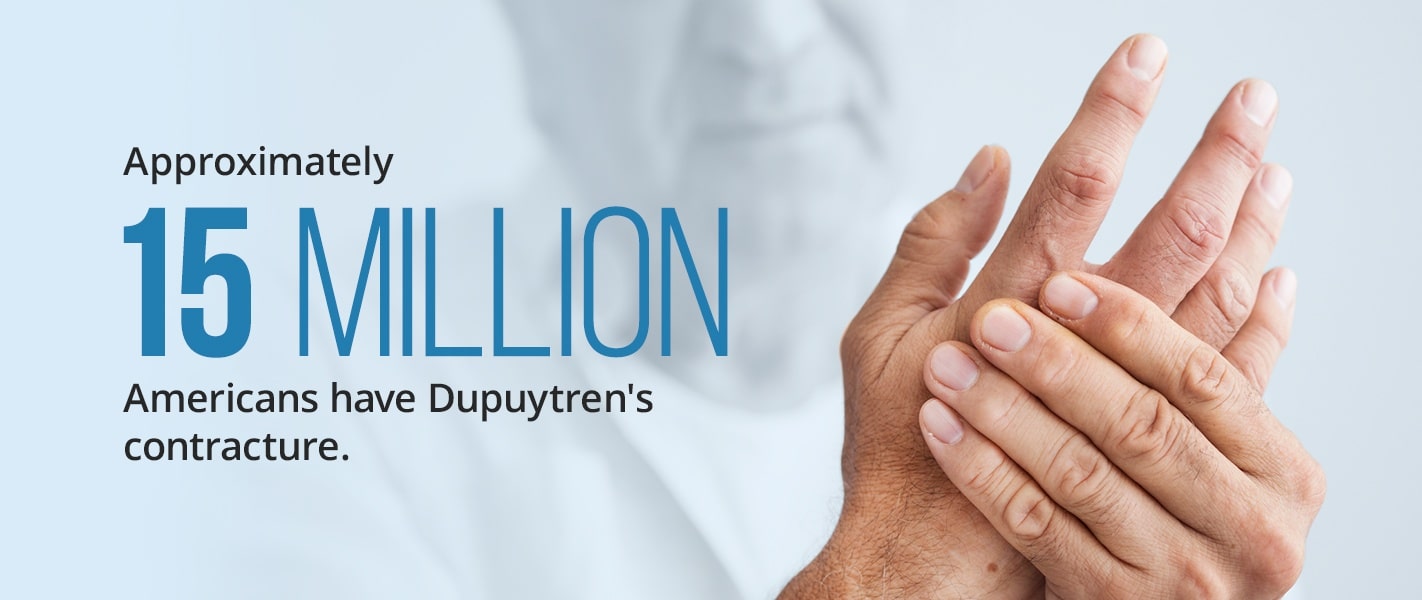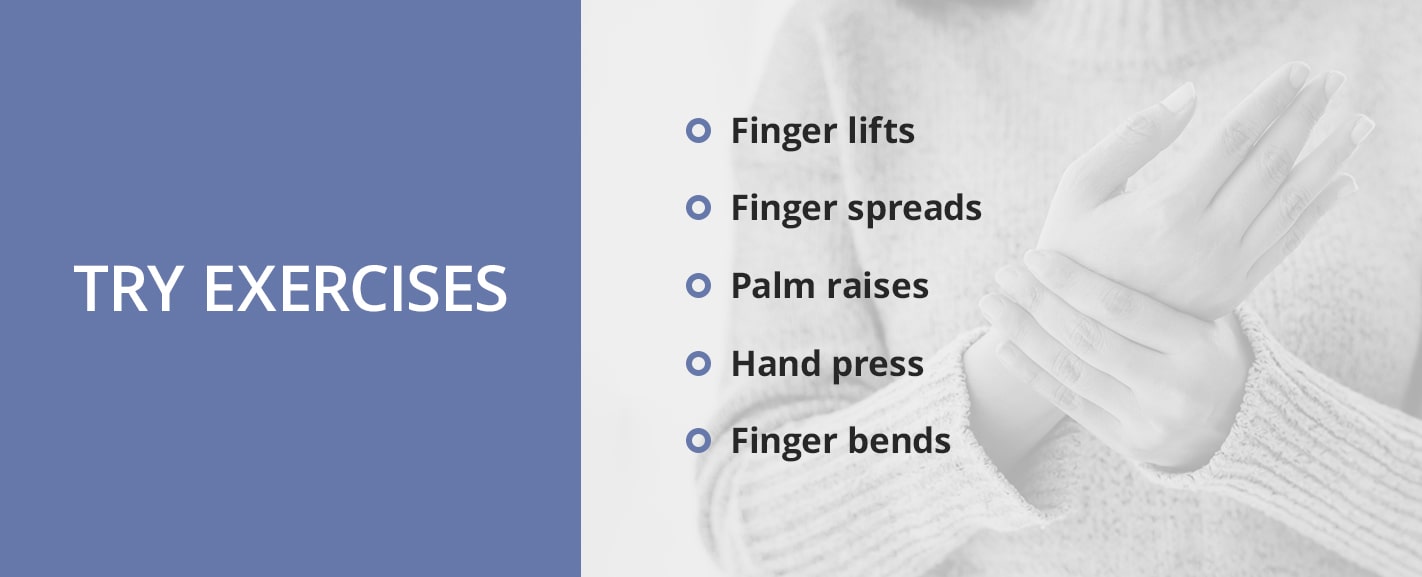
We use our hands every day without thinking about it — whether we’re making a cup of coffee, picking up the phone, typing at a desk or handling tools. As we age, different conditions can affect manual dexterity and make simple tasks we took for granted much more difficult to accomplish.
Over time, Dupuytren’s disease, also known as Dupuytren’s contracture, can affect the palm of the hand and the little and ring fingers. What is the best treatment for Dupuytren’s contracture? Can Dupuytren’s contracture go away by itself? Learn about how this condition develops, what you can do at home to treat it and when it is time to seek professional treatment from a doctor.

What Is Dupuytren’s Disease?
Approximately 15 million Americans have Dupuytren’s contracture. The symptoms of Dupuytren’s contracture vary depending on the progression of the disease. In the early stages, you may notice the skin of your palm thickening. As it progresses, the Dupuytren’s disease condition will change noticeably. The thickened skin on the palm of your hand may form a hard lump. Usually, this diseased tissue is not painful to the touch, but it may be a bit sensitive. Eventually, that tissue will begin to form cords that reach up through the palm to the fingers. As these cords tighten, they may cause the fingers to contract.
In the later stages of the disease, the contraction of the fingers can become extreme, curling the affected fingers very close to the palm. Typically, the ring and little fingers are affected by this condition, although other fingers may be involved in rare cases. Dupuytren’s disease can also impact both hands. If this is the case, the condition will usually be more severe on one hand.
The following groups of people may be at risk for developing Dupuytren’s disease:
- People over the age of 50: Dupuytren’s disease is more likely to develop in older adults.
- People with family history: Genetics play a role in the likelihood of developing Dupuytren’s contracture. If someone in your immediate family has the condition, your risk of developing it is higher. Ancestry also plays a role. People with Northern European descent in their family trees are at a higher risk.
- Men: Men have a higher risk than women of developing Dupuytren’s disease. They are also more likely to develop severe cases.
- People with certain health conditions: Dupuytren’s contracture risk is linked to a number of different health conditions, including epilepsy and diabetes. Additionally, alcoholism and tobacco use have been linked to the condition. The contracture tends to be more severe in people with alcohol use disorder.
Home Remedies for Dupuytren’s Disease
How do you reverse Dupuytren’s contracture? Unfortunately, there is no cure for Dupuytren’s contracture. Treatment focuses on minimizing the systems of the disease. While medical treatment is an option — and sometimes a necessity — there are a number of home remedies you can try to treat Dupuytren’s contracture:
1. Reduce Palm Pressure
The skin on the palm of the hand is where this disease starts. You can help manage your symptoms by protecting the affected hand or hands:
- Practice a looser grip: When we grip something like a tool or a cup of water, the palm usually curls around the object. Try to remember to protect your hands whenever you need to grip something by using lighter pressure.
- Wear gloves: Some objects, like various tools, require a tight grip in order to be used effectively. Try to mitigate some of that pressure by wearing gloves or using a type of cushion, such as tape, to minimize the amount of pressure being placed on your affected hand.

2. Try Exercises
Stretching does help Dupuytren’s contracture, and there a number of exercises you can do to help manage this condition. Exercises and stretches will not necessarily stop or slow the progression of the contracture, but they are helpful options during the early stages of Dupuytren’s disease:
- Finger lifts: In one of the most simple exercises, you can lay your palm flat on a smooth surface, like a table or desk. Next, practice raising each finger one at a time, pausing after each raise for a few seconds. You can repeat this exercise several times per day.
- Finger spreads: With your palm on a flat surface, you can also stretch your fingers by spreading them wide and drawing them back in together.
- Palm raises: Another exercise involves leaving your fingers flat on a surface while raising and lowering only your palm.
- Hand press: You can also try different exercises without a flat surface. First, place your hands in a prayer position. Then, gently push the palms and fingers of both hands together.
- Finger bends: Another option is holding your hands in front of you, bending the first two joints of the fingers down and straightening them.
It’s important to remember to go easy on yourself. Stretching to the point of pain can do more harm than good. If the contracture has already begun on any of your fingers, you can use your other hand to push the fingers back into a straight position and hold for a few seconds. You can create an exercise routine and stretch the affected hands multiple times a day.
While gripping with high pressure is not a recommended approach to managing this condition, you can still practice the gripping motion. Picking up objects of different size and shape can help maintain your grip strength and the dexterity in that hand. You can also practice gripping something soft, like a towel, to help maintain a grasping motion.

3. Utilize Massage
Massage is a good follow-up to exercise, but it can be beneficial as a standalone activity. You can conduct a gentle massage of the whole hand, including the palm and fingers, with your unaffected hand. Or, you can ask a family member or friend to lend their hands to the task.
Remember to be gentle as you massage the hand. Rub the area including and around the thickening tissue of the palm, and work your way up to the fingers. You may be able to find a professional massage therapist with experience working with Dupuytren’s disease if you would like some outside help. When pursuing professional massage therapy, remember the earlier you get started the better. Massage is less likely to help your symptoms in the later stages of the disease.
Massages may be accompanied by heat, oils and lotions. Products with anti-inflammatory ingredients may also be helpful. Alternatively, you can use a simple warm water soak or heat pack on your hand.

4. Eat a Healthy Diet
What you eat may seem unrelated to the condition of your hand, but diet changes can actually help reduce the symptoms associated with Dupuytren’s contracture. If you are middle-aged or have a condition like diabetes — roughly 5% of people with Dupuytren’s contracture have Type 1 or Type 2 diabetes — your doctor has probably already talked to you about the importance of making healthy eating part of your life.
Once it becomes a habit, eating healthy may feel easy. But, if you aren’t sure where to start, it can take a little time to learn what works for your new meal plan. A healthy diet does not necessarily mean a boring or bland diet. It can vary widely from person to person. There are a few good rules to follow:
- Consider portion sizes: Whether you are having a main dish or a dessert, try to keep the amount you eat reasonable and listen to your body to eat to fullness.
- Look for whole and fresh foods: When it comes to selecting foods, try to opt for whole and fresh options. Try cooking with fresh vegetables instead of canned. Opt for fresh fruit instead of canned fruit cocktail. Look for whole grains. These changes can help cut out unhealthy ingredients, such as sugars and preservatives.
- Reduce fat consumption: You can also opt for less fatty options of your favorite foods. Still enjoy dairy products, but go with the low-fat version. Still include meat in your diet, but look for healthier options. Try turkey burgers instead of beef burgers. Find new ways to cook lean meat, like chicken breast or fish.
- Consume anti-inflammatory foods: Foods eaten as a part of an anti-inflammatory diet may be a helpful consideration as well. These types of foods can include green leafy vegetables, fatty fish, fruits and nuts.
Certain foods can potentially contribute to your symptoms. As a natural part of a healthy diet, you will likely avoid large quantities of processed foods and foods high in salt, artificial sweeteners and additives.

5. Quit Smoking and Reduce Drinking
What aggravates Dupuytren’s contracture? Tobacco use is one of the top answers to this question. Research has shown that smoking cigarettes has a statistically significant link with Dupuytren’s contracture. Smoking can result in microvascular impairment, which could play a role in developing Dupuytren’s contracture.
Smoking cessation can be an important step early on in the progression of the disease. Eliminating tobacco use can have a number of other beneficial results for your health, including:
- Reducing your risk of developing certain cancers
- Improving lung function
- Improving cardiovascular function
- Reducing the risk of developing diabetes, which is a condition associated with a risk of Dupuytren’s disease
Heavy drinking is also associated with a higher chance of getting this condition. Having a drink with dinner or cocktails with friends is not likely to affect your risk of developing Dupuytren’s disease. But heavy alcohol consumption can increase your risk and is associated with a number of potential health problems, including high blood pressure and liver damage. Consider cutting back on your alcohol consumption to help manage your condition.
Alcohol use disorder and smoking cigarettes commonly go hand in hand. It can be difficult to quit these addictive substances, and you may need outside support to do so, but the health benefits can be significant.

6. Take Supplements
In addition to eating healthy and embracing healthy lifestyle choices, you can add daily supplements to your routine. Certain supplements can help reduce inflammation, which may play a role in managing the symptoms of Dupuytren’s disease. Though the efficacy of some supplements in relation to Dupuytren’s disease is still debated, you can try adding these vitamins, minerals and spices to your diet based on your doctor’s recommendations:
- Vitamin E: Vitamin E is an antioxidant. You likely ingest a certain amount in your regular diet, but you can also take it as a supplement. Vitamin E may play a potential role in protecting the body’s cells from damage.
- Zinc: Zinc is an important mineral for your overall health. It plays a role in a healthy immune system and wound healing.
- Magnesium: Magnesium, another important mineral, is an important part of any diet. Sometimes you do not get enough of it through the foods you eat, which is why you can opt to take a magnesium supplement. Low levels of magnesium have been connected to a higher risk of developing diabetes.
- Turmeric: Turmeric is a spice often used in cooking. It also widely used for its anti-inflammatory properties, which may be beneficial for someone with Dupuytren’s disease.
Professional Treatment for Dupuytren’s Disease
Dupuytren’s disease treatment can be done to some extent at home, but there may come a time when you need to talk to a professional. The progression of the disease is slow. Some people may never experience the contracture of their fingers. The disease may simply remain in the early stages, resulting only in thickening of the tissue on your palm.
In other cases, the disease may progress toward contraction. Carefully watch your symptoms over time. If you notice a significant change or the bend of your fingers begins to interfere with your daily life, it is time to seek professional treatment. Do not wait until your finger is bent all the way to your palm. Rather, seek help when your fingers reach a 20-degree or 40-degree bend. You can still receive treatment for severe contracture, but the chances of the treatment resulting in a completely straight finger are reduced.
The following are ways doctors can help treat Dupuytren’s disease:

1. Injections
Front-line treatments for Dupuytren’s disease tend to be minimally invasive. Your doctor may suggest an injection or a series of injections. While Dupuytren’s disease is typically characterized as painless, some people may feel pain in the nodes of tissue that form in the palm. In this case, you may be a candidate for a steroid injection. Steroids can reduce inflammation and pain. You may need to have a series of injections to manage your symptoms.
Steroids aren’t the only injection treatment available to people with Dupuytren’s disease. Some patients may benefit from collagenase injections. Collagenase is an enzyme designed to break down collagen, the tough protein that makes up much of our connective tissue. While we need collagen in our bodies, it makes up the cords that tighten and force the fingers toward contraction in Dupuytren’s disease. The collagenase is injected directly into the cords in the hand with the goal of breaking down that collagen.
Following the injection, usually the day after, your doctor will likely use manual manipulation of the finger to continue breaking down the tissue and work your finger toward straight positioning. These injections are FDA-approved. Like steroid injections, you may need to undergo more than one course of treatment with collagenase.
2. Needling
Needle aponeurotomy, also called needling or percutaneous needle fasciotomy, is another minimally invasive treatment option for Dupuytren’s disease. This treatment option, which can be performed in your doctor’s office, involves placing a needle in the tough tissue that is causing the contracture of your fingers. Your hand will be numbed before the procedure begins.
Your doctor will use the needle to puncture the tissue in your hand with the goal of separating that tissue. The procedure will be followed by manual manipulation to help straighten the affected fingers. Needling may also be complemented by a steroid injection, which is given to reduce swelling.
Following the needling procedure, you will need a few days to reduce swelling and soreness. You can use an ice pack to help with these symptoms. While you can use the treated hand for small activities, like eating, you will need one to two weeks to regain full use of the hand. Your doctor may also instruct you to wear a brace on the affected hand following the procedure. Most people do not require therapy following a needling procedure.

3. Surgery
Surgery may be necessary in more severe cases of Dupuytren’s disease. When the disease progresses to the point of acute contracture that makes use of the hand difficult, minimally invasive treatment options may no longer be viable. Surgery involves making an incision and removing the diseased tissue. While surgery may be more invasive, it does have the benefit of offering a longer-lasting release of contracture.
Once the affected tissue is removed, your doctor will stitch the incisions closed. Following surgery, your physician may prescribe therapy to help you during recovery and to improve the long-term outcome of the procedure. You may also be required to wear splints and bandages following surgery. The length of your recovery time following the procedure will depend on the severity of the Dupuytren’s disease and the extent of the surgery.
In serious cases of Dupuytren’s disease, you may need to undergo revision surgery. The initial surgery involves removing the affected tissue, but it does not address the underlying cause of the disease. Revision surgery may be necessary to address the recurrence of the collagen causing the contracture in your hand. These surgeries tend to be more complicated due to the presence of scar tissue.
Undergoing surgery or a minimally invasive treatment does not mean you have to stop using your home remedies. Changes like a healthy diet and certain supplements can help improve your overall health and may help slow the progression of the disease. The medical community has yet to find a cure for Dupuytren’s disease, so there is a possibility it will return following treatment. Watch your symptoms carefully, try out home remedies to see what works for you and ask for help when you need it.
Seek Professional Treatment From OrthoBethesda
At OrthoBethesda, we understand the frustrating impact Dupuytren’s disease may have on your life. Our skilled team is here to provide the treatment options that fit your unique needs. If you think it is time for professional treatment, reach out to us with questions, or book an appointment today.

